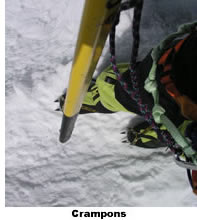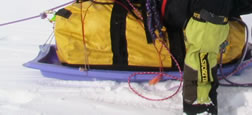6. Backpack, 65 litre capacity. May be loaded with up to 80 pounds of gear, internal and external.
7. Ice axe, with leash secured to my harness and immediately accessible if I fall in a crevasse.
8. Heavy duty cargo bag, 100 litre capacity, filled with food, sleeping bag, tent, stove, fuel, etc.
9. Plastic sled. Typically, I’ll divide my load 60/40 between the sled and the backpack. In Alaska and Antarctica, we carried 50 pounds of gear in the backpack while pulling 80 in the sled. Sleds used on steeper terrain (Denali version) are sturdier with poles attached to straps on backpack, making control easier in crevasse fields.
10. Line securing sled to climber's harness or backpack. Cargo bag is lashed to sled.
11. Line securing cargo bag to personal harness also and also secured by ‘dummy cord’ to rope tying climbers together.
EVEREST GEAR
|






